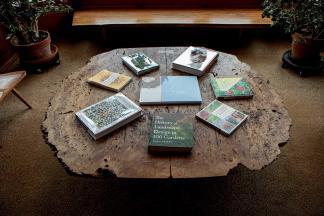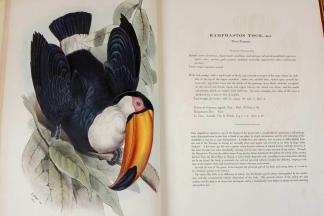By Suzy Frisch
 Tasked with designing a new Chinese garden at the Minnesota Landscape Arboretum, landscape gardener Erik Lemke needed to learn more about their signature style and aesthetic. After all, it’s not common knowledge, with only about a dozen Chinese gardens planted across North America. He headed to the on-site Andersen Horticultural Library and pored through its books about Chinese gardens.
Tasked with designing a new Chinese garden at the Minnesota Landscape Arboretum, landscape gardener Erik Lemke needed to learn more about their signature style and aesthetic. After all, it’s not common knowledge, with only about a dozen Chinese gardens planted across North America. He headed to the on-site Andersen Horticultural Library and pored through its books about Chinese gardens.
Lemke read about the design and construction of The Garden of Flowing Fragrance, or Liu Fang Yuan, at The Huntington library and botanical garden in California. In addition to teaching him about the design philosophy of Chinese gardens, the library’s books identified landscape designers at The Huntington who ultimately served as an important resource.
Lemke spent several days with them. He learned in-depth about Chinese gardens, their symbolism, and their sensibility, such as the harmonious relationship between stones, art, calligraphy, and architecture. “They taught me what a real Chinese garden was. They took my head and turned it 180 degrees,” he says. “Then when I went back to our books, my eyes were opened and I’m learning 10 times more.”
Landscape designers, Arboretum event planners, educators, nature lovers, and gardeners turn regularly to the Andersen Horticultural Library for its wealth of resources. The collection and archive perfectly align with the diverse offerings at the University of Minnesota Landscape Arboretum, helping its staff and visitors make the most of the flowers, plants, trees, wildlife, and grounds spread over 1,200 acres.
“The library is a wonderful thing to have at the Arboretum. It adds a lot to people’s visits,” says Arboretum Director Peter Moe. “They can visit the gardens or the Bee and Pollinator Discovery Center, and then come to the library and learn more about what they saw.”
Rich offering
Launched in 1958, the Arboretum was without a library until the new Education and Research Building (now the Snyder Building) was dedicated in 1974. Four thousand books were purchased and stored on teh St. Paul campus until the new library opened.
Former Governor Elmer Andersen, who also chaired the University’s Board of Regents, and his wife, Eleanor — were long advocates and supporters of the Libraries and the Arboretum.
The couple envisioned the library as a resource for Arboretum staff and the public. It reflects the institution’s place in a land-grant university, with its focus on high-level research, high-quality education, and excellent plant collections, Moe explains. “You can’t have all of those things without having a high-quality library,” he adds. “The fact that it’s a University of Minnesota library automatically raises its quality.”
Today the Andersen Horticultural Library is all of that and much more. It gives the public access to resources that are known worldwide, including a vast collection of 75,000 seed and nursery catalogs from 8,000 firms in two dozen countries, from the 1600s to the present.
The library’s Plant Information Online database dates back to the library’s earliest days. Staff continuously index hundreds of seed and nursery catalogs by plant, including scientific name and which nursery carries each variety. It also indexes bibliographic details of nearly 400,000 images of wild and cultivated plants from around the world, found in botanical and horticultural books and magazines. And it includes contact information and links to more than 2,700 current retail and wholesale seed and nursery firms.
The University built a complicated database for the library in the late 1990s, allowing the site to land on the internet soon after. Library Director Kathy Allen knows that people from around the world use the resource, and she often sees visitors take advantage of it, too.
“People come to the Arboretum and see all these wonderful gardens and amazing plants,” Allen says. “They love a particular plant and want to get it for themselves. Before, they would have to go through years and years of seed catalogs to find a nursery that carries that plant. Now it’s all online.”
Historians, landscapers, and gardeners enjoy digging through the seed catalogs — the third largest collection in the country — for their original artwork and historical insight. Nursery owners’ annual letters provide rich details, including news about that year’s crops or which employees serving in the military were killed in action . Others use the catalogs to do research for books, compare prices from various eras, or recreate historic gardens to celebrate special business anniversaries, Allen says.
Reaching out
 The Andersen Horticultural Library is an important point of outreach to the broader community and visitors of all ages, from young patrons who attend nature-based story times to parents and grandparents who take in exhibits featuring art from its rare volumes.
The Andersen Horticultural Library is an important point of outreach to the broader community and visitors of all ages, from young patrons who attend nature-based story times to parents and grandparents who take in exhibits featuring art from its rare volumes.
For example, a recent show displayed illustrated bird books from the library’s collection. Visitors can view art from the deluxe edition of The Birds of Minnesota by noted ornithologist Thomas Sadler Roberts, one of the founders of the University’s Bell Museum, and a stunning toucan from the cover of Edward Lear’s Birds.
A new joint project between the Arboretum and the library collects scientifically accurate fine art to celebrate and document the extensive ecosystem on site. Called Flora and Fauna Illustrata, this collection includes juried pieces by artists that capture the bounty of the Arboretum in watercolor, graphite, or colored pencil.
An annual exhibition covers a different theme each year, such as trees or spring plants. The library preserves the artwork in its permanent collection with plans to periodically display it. The current Flora and Fauna Illustrata exhibit features Minnesota hardy plants
“It ties in a lot with our collections, and it’s great to be able to partner with the Arboretum on this and document what is currently here at this point in time. It’s important, because it will change as the climate changes,” Allen says. “It’s another way to get the community engaged.”
An abundance of Nakashima
Some visitors to the Andersen Horticultural Library aren’t there to learn about plants and animals. Instead, they come for the furniture. The space is filled with about 80 pieces by acclaimed architect and master woodworker, George Nakashima.
Commissioned by the Andersens, the extensive collection of chairs, tables, shelving, and display cases makes for a warm and cozy setting. Nakashima created the furniture for the library mostly from black walnut, along with a striking coffee table crafted from the burl of a 400-plus-year-old English oak tree from the Sherwood Forest.
Nakashima’s furniture is known for highlighting nature’s imprint on the wood, such as insect damage or irregular growth. “It’s one of the largest collections of his furniture that is open to the public, where you can sit in a chair or work at a table,” says Librarian Kathy Allen. “It’s unusual to have this large of a collection.”
The library’s reading room, a light-filled space with high ceilings, natural wood beams, and the warm and inviting Nakashima furniture, creates a memorable space for enjoying a unique collection.
—Suzy Frisch





